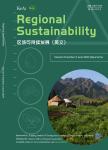Spatio-temporal variation of depth to groundwater level and its driving factors in arid and semi-arid regions of India
作者机构:Department of Economics and FinanceBirla Institute of Technology&SciencePilani333031India
出 版 物:《Regional Sustainability》 (区域可持续发展(英文))
年 卷 期:2024年第5卷第2期
页 面:103-122页
学科分类:081803[工学-地质工程] 07[理学] 08[工学] 070601[理学-气象学] 0818[工学-地质资源与地质工程] 0706[理学-大气科学]
主 题:Climate change Generalized additive model(GAM) Depth to groundwater level(DGWL) Climatic and anthropogenic variables Arid and semi-arid regions
摘 要:Climate change and increasing anthropogenic activities,such as over-exploitation of groundwater,are exerting unavoidable stress on groundwater *** study investigated the spatio-temporal variation of depth to groundwater level(DGWL)and the impacts of climatic(precipitation,maximum temperature,and minimum temperature)and anthropogenic(gross district product(GDP),population,and net irrigated area(NIA))variables on DGWL during *** study considered DGWL in 113 observation wells and piezometers located in arid western plains(Barmer and Jodhpur districts)and semi-arid eastern plains(Jaipur,Ajmer,Dausa,and Tonk districts)of Rajasthan State,*** methods were employed to examine the annual and seasonal patterns of DGWL,and the generalized additive model(GAM)was used to determine the impacts of climatic and anthropogenic variables on *** 1994-2020,except for Barmer District,where the mean annual DGWL was almost constant(around 26.50 m),all other districts exhibited increase in DGWL,with Ajmer District experiencing the most *** results also revealed that 36 observation wells and piezometers showed a statistically significant annual increasing trend in DGWL and 34 observation wells and piezometers exhibited a statistically significant decreasing trend in ***,32 observation wells and piezometers showed an statistically significant increasing trend and 37 observation wells and piezometers showed a statistically significant decreasing trend in winter;33 observation wells and piezometers indicated a statistically significant increasing trend and 34 had a statistically significant decreasing trend in post-monsoon;35 observation wells and piezometers exhibited a statistically significant increasing trend and 32 observation wells and piezometers showed a statistically significant decreasing trend in pre-monsoon;and 36 observation wells and piezometers reflected a statistically significant increasing trend and 30 observation



